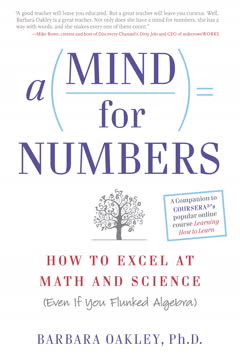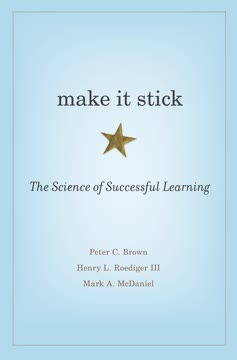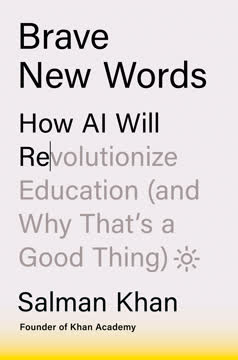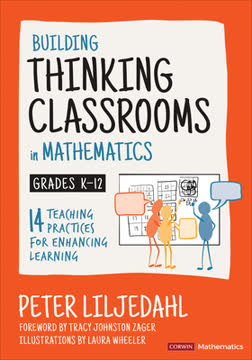Key Takeaways
1. Metacognition is the key to unlocking student potential
"If you teach students how to learn, and give them simple, straightforward strategies to use, they can significantly increase their learning and performance."
Metacognition defined. Metacognition is thinking about one's own thinking. It involves:
- Being consciously aware of oneself as a problem solver
- Monitoring, planning, and controlling one's mental processing
- Accurately judging one's level of learning
Power of metacognition. When students employ metacognition:
- They become proactive learners rather than passive recipients of information
- They can accurately assess their understanding and identify gaps in knowledge
- They develop the ability to teach themselves, leading to dramatic improvements in performance
Implementing metacognition. Faculty can introduce metacognition by:
- Explaining the concept and its benefits to students
- Providing specific metacognitive strategies for learning course material
- Encouraging students to reflect on their learning processes and outcomes
2. Bloom's Taxonomy provides a framework for deeper learning
"I hope it is clear at this point that a fixed mindset can spell disaster, whether a student is judged as 'gifted' or 'slow.'"
Understanding Bloom's Taxonomy. Bloom's Taxonomy is a hierarchical model of learning objectives:
- Remembering
- Understanding
- Applying
- Analyzing
- Evaluating
- Creating
Applying Bloom's in education. Faculty can use Bloom's Taxonomy to:
- Design assignments and assessments that target higher-order thinking skills
- Help students understand the depth of learning required for success in college
- Encourage students to move beyond memorization to application and analysis
Student benefits. When students understand Bloom's Taxonomy:
- They recognize the difference between surface-level and deep learning
- They set more appropriate learning goals for themselves
- They develop strategies to reach higher levels of cognitive engagement with course material
3. The study cycle and intense study sessions drive academic success
"If you do two or three sessions during the day between classes, and another couple of sessions at night, you will have studied 4–5 hours that day without breaking a sweat."
The study cycle explained. The study cycle consists of five steps:
- Preview
- Attend class
- Review
- Study
- Assess
Intense study sessions. These focused learning periods typically include:
- Setting specific goals for the session
- Engaging in active learning tasks for 30-50 minutes
- Taking a short break
- Reviewing what was learned
Benefits of this approach. By implementing the study cycle and intense study sessions:
- Students distribute their learning over time, enhancing retention
- They actively engage with material, leading to deeper understanding
- They regularly assess their progress, allowing for timely adjustments in strategy
4. Active reading strategies dramatically improve comprehension
"When students employ metacognition, they become consciously aware of themselves as problem solvers, which enables them to actively seek solutions to any problems they may encounter, rather than relying on others to tell them what to do or to answer their questions."
Three-step active reading process:
- Preview the material before reading
- Develop questions you expect the passage to answer
- Read one paragraph at a time, paraphrasing as you go
Benefits of active reading:
- Increases engagement with the text
- Improves comprehension and retention of information
- Helps identify areas of confusion or misunderstanding
Additional active reading techniques:
- Highlighting key information
- Taking notes in the margins
- Creating concept maps or outlines
- Summarizing main points after each section
5. Effective homework strategies lead to mastery of course material
"Practice problems, wherever they come from, are your brain's best resource for demonstrating that it can do all the problems without relying on an example as a guide."
Key homework strategies:
- Begin homework as soon as it's assigned
- Treat homework problems as if they were test questions
- Work problems without looking at solutions or examples
- Check answers only after attempting problems independently
Benefits of effective homework practices:
- Deeper understanding of course concepts
- Improved problem-solving skills
- Better preparation for exams
- Identification of areas needing further study
Overcoming common pitfalls:
- Avoid the temptation to look up solutions prematurely
- Don't rely on memorization of problem types
- Seek help from instructors or tutors when truly stuck, not as a first resort
6. Growth mindset and positive self-talk boost motivation and performance
"What you believe and what students believe both have a significant impact on their motivation and performance."
Understanding mindset. Carol Dweck's research identifies two mindsets:
- Fixed mindset: Intelligence is innate and unchangeable
- Growth mindset: Intelligence can be developed through effort and learning
Cultivating a growth mindset. Strategies include:
- Emphasizing effort over innate ability
- Viewing challenges as opportunities for growth
- Embracing mistakes as learning experiences
Power of positive self-talk. Students can improve performance by:
- Monitoring their internal dialogue
- Challenging negative thoughts
- Replacing self-defeating statements with encouraging ones
7. Faculty can empower students through targeted teaching strategies
"Even though learning centers like the LSC at Cornell and the CAS at LSU have existed for decades, I have observed in my 43 years of teaching that the learning strategies taught there still have not reached the mainstream."
Key teaching strategies:
- Establish clear, high expectations
- Provide frequent assessments and feedback
- Introduce metacognitive learning strategies
- Connect course material to students' interests and goals
- Encourage active learning in the classroom
Creating a supportive learning environment:
- Express confidence in students' abilities to succeed
- Offer opportunities for early success to build confidence
- Provide scaffolding for challenging tasks
Promoting student responsibility:
- Clarify student responsibilities for learning
- Encourage use of office hours and learning resources
- Foster a classroom community of engaged learners
8. Time management and test preparation are crucial skills for success
"Remember that small chunks of time are just as useful as big chunks where homework is concerned."
Effective time management techniques:
- Use a semester calendar to track major assignments and exams
- Create a weekly schedule allocating time for study, work, and personal activities
- Implement the "Power Hour" concept for focused study sessions
Test preparation strategies:
- Begin preparing well in advance of the exam date
- Create and take practice tests
- Review and analyze past exams to identify areas for improvement
- Use active recall techniques rather than passive review
Managing test anxiety:
- Practice relaxation techniques
- Maintain a positive mindset
- Arrive early to the exam location
- Read all instructions carefully before beginning
9. Learning centers are valuable resources for all students
"Learning center professionals can impact learning at both ends of the performance spectrum, and at all levels in between."
Services offered by learning centers:
- One-on-one tutoring
- Group study sessions
- Workshops on learning strategies and time management
- Writing support
- Test preparation assistance
Benefits of utilizing learning centers:
- Personalized support for academic challenges
- Exposure to new learning techniques
- Opportunities for collaborative learning
- Access to resources beyond the classroom
Overcoming stigma:
- Recognize that seeking help is a sign of strength, not weakness
- Understand that even high-performing students can benefit from learning center services
- View learning centers as tools for optimizing academic performance, not just remediation
</reponse>
Last updated:
FAQ
What's Teach Students How to Learn about?
- Focus on Learning Strategies: The book emphasizes teaching students effective learning strategies to enhance their metacognition, study skills, and motivation. It provides practical, research-based methods applicable across various disciplines.
- Three Key Ms: Saundra Yancy McGuire focuses on mindset, motivation, and metacognition, which are crucial for student success in higher education.
- Transformative Approach: McGuire shares her journey from a traditional instructor to an academic transformer, illustrating how teaching students how to learn can lead to significant improvements in their academic performance.
Why should I read Teach Students How to Learn?
- Practical Application: The book is filled with actionable strategies that educators can implement immediately to improve student learning outcomes.
- Research-Based Insights: Grounded in solid educational research, it is a credible resource for understanding how students learn and how to facilitate that process effectively.
- Empowerment for Educators: It empowers educators to take responsibility for student learning by providing them with the tools to teach students how to learn, rather than just delivering content.
What are the key takeaways of Teach Students How to Learn?
- Metacognition is Essential: Understanding metacognition—thinking about one’s own thinking—is crucial for students to become independent learners.
- Mindset Matters: The book discusses the importance of fostering a growth mindset in students, encouraging them to believe that their intelligence can be developed through effort and effective strategies.
- Practical Strategies: McGuire provides specific strategies for both students and instructors, including the study cycle, active reading techniques, and the importance of teaching material to others.
What are the best quotes from Teach Students How to Learn and what do they mean?
- “If you teach students how to learn...”: This quote encapsulates the book's core message that effective teaching involves equipping students with the skills to learn independently.
- “Your grades are not based on how smart you are...”: This emphasizes the importance of effort and strategy over innate ability, reinforcing the growth mindset concept.
- “Mistakes are good.”: This quote highlights the value of learning from errors, encouraging students to view mistakes as opportunities for growth rather than failures.
What is metacognition, and why is it important in Teach Students How to Learn?
- Definition of Metacognition: Metacognition refers to the awareness and understanding of one’s own thought processes, involving self-regulation and reflection on how one learns.
- Empowerment Through Awareness: By teaching metacognitive strategies, students learn to monitor their understanding and adjust their learning strategies accordingly.
- Connection to Learning: The book illustrates how metacognition helps students become proactive learners, enabling them to take control of their educational journey.
How does Teach Students How to Learn suggest improving student motivation?
- Understanding Motivation: The book defines motivation as the personal investment an individual has in reaching a desired outcome, emphasizing the need for students to find value in their learning goals.
- Creating a Supportive Environment: McGuire suggests that faculty can boost motivation by fostering a supportive classroom atmosphere where students feel encouraged and capable of succeeding.
- Strategies for Faculty: The book provides specific strategies for faculty to enhance student motivation, such as setting clear expectations and using engaging teaching methods.
What are the specific strategies for teaching metacognitive learning strategies in Teach Students How to Learn?
- Study Cycle: McGuire introduces the study cycle, which includes steps like previewing material, attending class, reviewing notes, and self-assessing understanding.
- Active Reading Techniques: Strategies for active reading include previewing texts, generating questions, and paraphrasing content to enhance comprehension and retention.
- Teaching to Others: One effective strategy is having students teach the material to peers, which reinforces their understanding and highlights gaps in their knowledge.
How can I apply the concepts from Teach Students How to Learn in my classroom?
- Implement Learning Strategies: Integrate the metacognitive strategies discussed in the book into your teaching practices, such as the study cycle and active reading techniques.
- Foster a Growth Mindset: Encourage students to adopt a growth mindset by sharing success stories and emphasizing that effort and strategy are key to academic success.
- Create a Supportive Environment: Establish a classroom culture that values mistakes as learning opportunities and promotes collaboration among students.
What role does mindset play in student success according to Teach Students How to Learn?
- Growth vs. Fixed Mindset: The book discusses Carol Dweck’s research on mindsets, explaining that students with a growth mindset are more likely to embrace challenges.
- Impact on Performance: A positive mindset can lead to increased motivation and better academic performance, as students believe in their ability to improve.
- Strategies for Change: McGuire provides strategies for educators to help students shift from a fixed mindset to a growth mindset, enhancing their learning outcomes.
What are some effective learning strategies mentioned in Teach Students How to Learn?
- Active Reading Techniques: The book suggests previewing material, developing questions before reading, and paraphrasing information to enhance comprehension.
- Homework Without Examples: Students are encouraged to attempt homework problems without looking at examples first, fostering problem-solving skills.
- Intense Study Sessions: The author advocates for structured study sessions that include breaks and focused goals, improving retention and understanding.
How does the author define metacognition in Teach Students How to Learn?
- Thinking About Thinking: Metacognition is described as the awareness and understanding of one’s own thought processes, involving self-regulation and reflection.
- Self-Assessment: The book emphasizes the importance of self-assessment in learning, encouraging students to evaluate their understanding.
- Impact on Learning: Developing metacognitive skills helps students become more effective learners, as they learn to identify what works best for them.
How does Teach Students How to Learn address the issue of educational equity?
- Equity in Learning: McGuire emphasizes that all students, regardless of their background, can succeed if they are taught how to learn effectively.
- Strategies for Underprepared Students: The book provides specific strategies for helping underprepared students develop the skills they need to thrive academically.
- Empowerment Through Education: By focusing on teaching students how to learn, educators can help bridge the gap in educational equity.
Review Summary
Teach Students How to Learn receives mostly positive reviews, with an average rating of 4.18/5. Readers appreciate the practical strategies for improving student metacognition and study skills. Many find the book engaging and valuable for both educators and students. Some criticisms include repetitiveness, dry writing style, and a focus on traditional teaching models. Overall, reviewers praise the book's emphasis on helping students develop effective learning strategies and its potential to improve academic performance.
Similar Books










Download PDF
Download EPUB
.epub digital book format is ideal for reading ebooks on phones, tablets, and e-readers.





